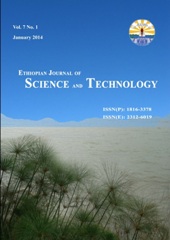Physicochemical, functional and pasting properties of cassava starch: Potential of developing flexible packaging film
Abstract
Developing multipurpose flexible packaging mainly from starch film is essential both from food safety and environmental issues. Starch has various functional, pasting, and physicochemical properties. A study was conducted to evaluate the physicochemical, functional, and pasting properties of Qulle (Q) and Kello (K) cassava starch and develop plastic film. A Completely Randomized Design with the main responses such as vital proximate composition, viscosity profiles, water absorption capacity, oil absorption property, and film strength was employed. All data analysis were performed using Design Expert software version 7.0.0. The result showed K starch moisture of 11.4%, ash 1.1%, fat 0.11%, protein 0.52%, fiber 0.01%, and carbohydrate 86.85%. Q cassava starch moisture was 10.6%, ash 0.13%, fat 0.13%, protein 0.35%, fiber 0.09%, and carbohydrate 88.7%. The proximate parameters showed a significant difference between Q and K’s starches at p < 0.05. The amylose of Q starch was 26.29 % and K was19.16%, which were significantly different (p < 0.05). Variations in amylose affected the functional properties of starches. The peak and breakdown viscosities of K starch were higher indicating that the final viscosity and peak temperature of Q starch affects its application. The functional and pasting parameters of Q and K starches varied significantly (p < 0.05). The plastic film developed from Q starch had low moisture, water absorption capacity, high transparency, tensile strength, and water solubility. It is concluded that Q cassava starch-based film is recommended for multipurpose flexible packaging. Overall, the functional and pasting properties of Q and K starches are influenced by amylose and proximate composition which impact their applications.
Copyright (c) 2025 Desta Geta Kume, Kumsa Kuffi, Lemessa Etana Bultum, Shimeles Shumi Raya

This work is licensed under a Creative Commons Attribution-NonCommercial-NoDerivatives 4.0 International License.

